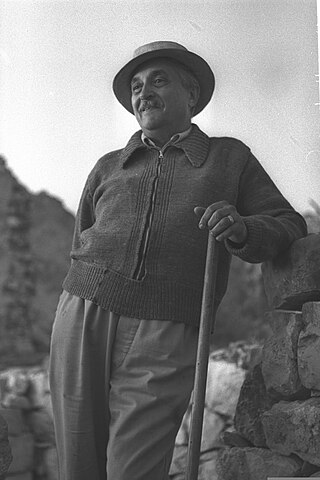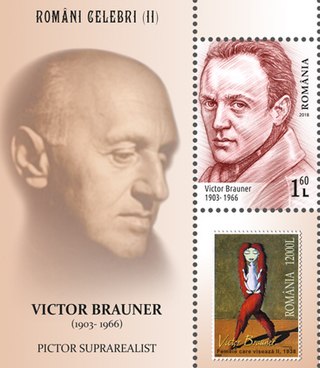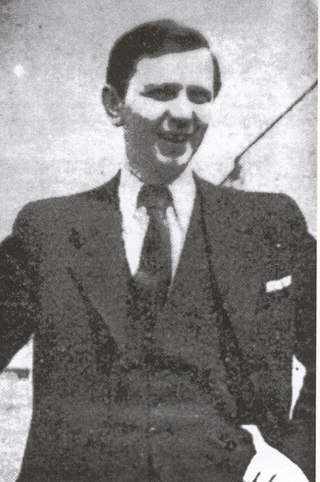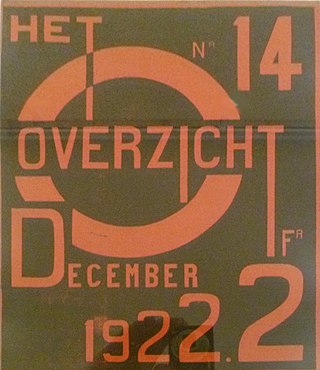Related Research Articles

Dada or Dadaism was an art movement of the European avant-garde in the early 20th century, with early centres in Zürich, Switzerland, at the Cabaret Voltaire, founded by Hugo Ball with his companion Emmy Hennings, and in Berlin in 1917. New York Dada began c. 1915, and after 1920 Dada flourished in Paris. Dadaist activities lasted until the mid 1920s.

Tristan Tzara was a Romanian avant-garde poet, essayist and performance artist. Also active as a journalist, playwright, literary and art critic, composer and film director, he was known best for being one of the founders and central figures of the anti-establishment Dada movement. Under the influence of Adrian Maniu, the adolescent Tzara became interested in Symbolism and co-founded the magazine Simbolul with Ion Vinea and painter Marcel Janco.

Marcel Janco was a Romanian and Israeli visual artist, architect and art theorist. He was the co-inventor of Dadaism and a leading exponent of Constructivism in Eastern Europe. In the 1910s, he co-edited, with Ion Vinea and Tristan Tzara, the Romanian art magazine Simbolul. Janco was a practitioner of Art Nouveau, Futurism and Expressionism before contributing his painting and stage design to Tzara's literary Dadaism. He parted with Dada in 1919, when he and painter Hans Arp founded a Constructivist circle, Das Neue Leben.

Victor Brauner was a Romanian painter and sculptor of the surrealist movement.
The Vilna Troupe, also known as Fareyn Fun Yiddishe Dramatishe Artistn and later Dramă şi Comedie, was an international and mostly Yiddish-speaking theatre, one of the most famous in the history of Yiddish theater. It was formed in and named after the city of Vilnius (Vilna) in the Russian Empire, later capital city of Lithuania. Distinctly Modernist, and strongly influenced by Russian literature and by the ideas of Konstantin Stanislavski, their travels in Western Europe and later to Romania played a significant role in the dissemination of a disciplined approach to acting that continues to be influential in the present day.
Events from the year 1924 in art.

Constructivism is an early twentieth-century art movement founded in 1915 by Vladimir Tatlin and Alexander Rodchenko. Abstract and austere, constructivist art aimed to reflect modern industrial society and urban space. The movement rejected decorative stylization in favour of the industrial assemblage of materials. Constructivists were in favour of art for propaganda and social purposes, and were associated with Soviet socialism, the Bolsheviks and the Russian avant-garde.

unu was the name of an avant-garde art and literary magazine, published in Romania from April 1928 to December 1932. Edited by writers Sașa Pană and Moldov, it was dedicated to Dada and Surrealism.

Ilarie Voronca was a Romanian avant-garde poet and essayist.

Sașa Pană was a Romanian avant-garde poet, novelist, and short story writer.

Der Sturm was a German avant-garde art and literary magazine founded by Herwarth Walden, covering Expressionism, Cubism, Dada and Surrealism, among other artistic movements. It was published between 1910 and 1932.
Contimporanul was a Romanian avant-garde literary and art magazine, published in Bucharest between June 1922 and 1932. Edited by Ion Vinea, Contimporanul was prolific in the area of art criticism, dedicating entire issues to modern art phenomena, and organizing the Bucharest International Modern Art Exhibit in December 1924.

Scarlat Callimachi or Calimachi was a Romanian journalist, essayist, futurist poet, trade unionist, and communist activist, a member of the Callimachi family of boyar and Phanariote lineage. He is not to be confused with his ancestor, hospodar Scarlat Callimachi.

János Mattis-Teutsch or Máttis-Teutsch, Mátis-Teutsch was a Romanian painter, sculptor, graphic artist, art critic, and poet. Best known for his Seelenblumen ("Soulflowers") cycle of paintings, he was an important contributor to the development of modern art and avant-garde trends inside Romania. He was the grandfather of the artist Waldemar Mattis-Teutsch.
Simbolul was a Romanian avant-garde literary and art magazine, published in Bucharest between October and December 1912. Co-founded by writers Tristan Tzara and Ion Vinea, together with visual artist Marcel Janco, while they were all high school students, the journal was a late representative of international Symbolism and the Romanian Symbolist movement. Other figures associated with the magazine were Adrian Maniu, Emil Isac and Claudia Millian, the wife of poet and Tzara's mentor Ion Minulescu. Simbolul also featured illustrations by, among others, Janco and his teacher Iosif Iser.
Sidney Hunt (1896–1940) was a British draughtsman, painter, poet and editor who published the avant-garde journal Ray between 1926 and 1927.

Dragan Aleksić was a Serbian Dadaist poet, author, journalist and filmmaker. He was the founder of the Yugoslavian branch of Dadaism, termed "Yugo-Dada".
N. D. Cocea was a Romanian journalist, novelist, critic and left-wing political activist, known as a major but controversial figure in the field of political satire. The founder of many newspapers and magazines, including Viața Socială, Rampa, Facla and Chemarea, collaborating with writer friends such as Tudor Arghezi, Gala Galaction and Ion Vinea, he fostered and directed the development of early modernist literature in Romania. Cocea later made his name as a republican and anticlerical agitator, was arrested as an instigator during the 1907 peasant revolt, and played a leading role in regrouping the scattered socialist clubs. His allegiances however switched between parties: during World War I, he supported the Entente Powers and, as a personal witness of the October Revolution, the government of Soviet Russia, before returning home as a communist.

Het Overzicht was a Dutch language literary magazine published in Antwerp, Belgium, between 1921 and 1925. Until its cessation in 1925 it was the major avant-garde magazine in the country and published a total of 24 issues.
Stephan Roll was a Romanian poet, editor, film critic, and communist militant. An autodidact, he played host to the Romanian avant-garde at his father's dairy shop, publishing his work in short-lived reviews and in two volumes of poetry. As one of the editors of the magazine unu, he turned from Constructivism, Futurism and jazz poetry to the more lyrical format of Surrealism. Roll's political radicalism seeped into his avant-garde activity, and produced a split inside the unu group; Roll's faction discarded Surrealism in favor of proletarian literature, and affiliated with the underground Romanian Communist Party.
References
- 1 2 3 Peter Brooker; Sascha Bru; Andrew Thacker; Christian Weikop (19 May 2013). The Oxford Critical and Cultural History of Modernist Magazines: Europe 1880 - 1940. Oxford University Press. p. 1173. ISBN 978-0-19-965958-6 . Retrieved 3 August 2015.
- ↑ "The Romanian Avant-Garde (03/1999)". Institutul Cultural Roman. Retrieved 3 August 2015.
- ↑ Adriana Copaciu. "How to be Transnational? Identity Trajectories of the Romanian Avant-Garde Magazines" (PDF). University of Petru Maior. Retrieved 3 August 2015.